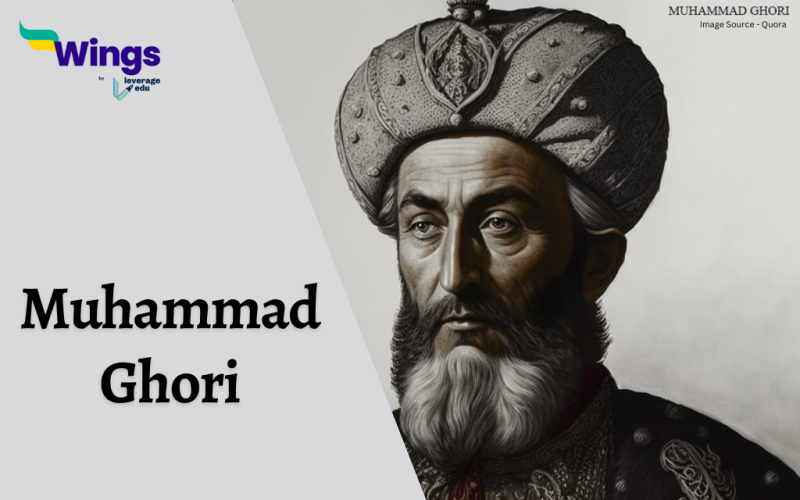Muhammad Ghori was the leader of the Ghori Dynasty who expanded the Muslim empire to India. He is often regarded as the true architect of the Muslim empire in India. Moreover, Ghori succeeded where previous rulers had failed to further establish Muslim dominance across significant portions of the Indian subcontinent. All in all, Muhammad Ghori’s conquests played a key role in laying the foundation for the Muslim rule that followed.
Table of Contents
What was the Early Life of Muhammad Ghori?
In the year 1144, Muhammad Ghori was born in Ghor, which is present-day Afghanistan. His father, Baha al-Din Sam 1, was a Ghurid ruler who passed away when Muhammad was a child. Muhammad Ghori is also known as Muhammad of Ghor and Mu’izz ad-Din Muhammad ibn Sam. In his early years, his mother affectionately referred to him as “Zangi” because of his dark complexion. After his coronation in Ghazna, Muhammad adopted the title “Malik Shihabuddin.”
Furthermore, when Ghiyath al-Din Muhammad, the senior in the dyarchy passed away, Muhammad assumed the title of “al-Sultan al-Azam” which means the “Greatest Sultan.” Muhammad is praised as the “Sikander al-Thani” which means Second Alexander, on one of the colonnades in the Qutub Minar along with some of his golden mints circulated in India.
He was sent to India by his brother Ghiyath-al-Din-Mohammad, who was the ruler of the Ghur dynasty and sent him to conquer and establish the Ghur rule in the Indian Subcontinent by 1173 AD.
What were the Key Conquests of Muhammad Ghori in India?
Some of the important conquests undertaken by Muhammad Ghori in India are –
Multan
In the year 1175, Muhammad Ghori strategically chose the Gomal Pass over the Khyber Pass to swiftly access the coastal plains of Gujarat and advance into Peninsular India. Without a doubt, he opted for a shorter route, thus Ghori’s earliest campaign targeted the Qarmatians in Multan. The Qarmatians had earlier faced defeat in the 11th century by Mahmud of Ghazni though they had managed to recover authority over Multan and parts of Sindh. Nevertheless, despite a strong defence by the Qarmatians, Muhammad Ghori successfully conquered them and captured Multan.
Also Read: Tughlaq Dynasty: Rulers of Delhi Sultanate
First Battle of Tarain
Subsequently, in 1191, the Ghurid army which was led by Muhammad Ghori, came face to face with the Rajputs led by Prithviraj Chauhan near Tarain, now Taraori in Haryana, India. Moreover, even though the Rajputs achieved victory, Muhammad Ghori was able to escape and return to Ghazni.
After the defeat, the Ghurid armies retreated to Ghazni while leaving a force of 2000 soldiers under Zia ud-Din Tulaki at the fort of Tabarhind, which is present-day Bhatinda. Undoubtedly, this thought-out strategic move easily delayed the Rajput army for thirteen months. In the meantime, Muhammad Ghori during this period was able to raise a powerful army of 120,000, thus leading to the following Second Battle of Tarain.
Also Read: Lodi Dynasty
Second Battle of Tarain
Additionally, in the year 1192, the Second Battle of Tarain took place between the Ghurid forces and the Rajputs led by Prithviraj Chauhan again. Tarain is located roughly 110 kilometres north of Delhi, the second battle ended with the Ghurids being victorious. Unquestionably, this accomplishment memorialised the successful spread of the Ghurids into the northern Indian plains.
In Medieval Indian History, this very moment is highlighted and considered a milestone. The battle further resulted in the temporary weakening of the Rajput powers. Thus, this set the stage for the establishment of Muslim rule in North India, eventually leading to the formation of the Delhi Sultanate by Qutub-ud-din-Aibak.
What was the Fate of Muhammad Ghori?
On the 15th of March 1205, in Dhamaik, now a part of Pakistan, Muhammad Ghori passed away. While his army was resting and celebrating their victory across India he was assassinated while he was praying. There are various speculations as to who is responsible but that remains a mystery to date. However, some blame the Khokar Jatts or Ismaili Nizari. This assassination is regarded with scepticism in Indian historical accounts as they targeted Ghori’s army during their rest, a time of repose and evening prayer.
Relevant Blogs
| Khilji Rulers | Alauddin Khilji |
| Sayyid Dynasty | Babur |
| 50 Interesting History Facts | The Vijaynagar Empire |
| Battle of Panipat | Mughal Emperor Jahangir |
| History of Indian Art | Chola Dynasty |
FAQs
While Muhammad Ghori was praying, he was assassinated and died on the 15th of March, 1205. After the expansive victory of India, his army and he were in their restful space but they did not know what was to come.
Muhammad Ghori ruled India from 1202 to 1206 on his own. His victorious reign led to the formation of the Delhi Sultanate.
Muhammad Ghori defeated Prithviraj Chauhan, the Rajput leader in the Second Battle of Tarain. This was a momentous victory for the Ghurid army.
We hope you liked our blog. If you want to read more articles like this you can visit our general knowledge page on Indian History!
 One app for all your study abroad needs
One app for all your study abroad needs













